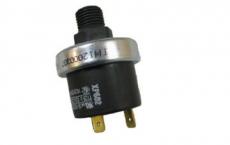Spring terminals. Tips for all occasions
We all know, breaks where it is delicate. Similarly, in the electrical circuit - in emergency modes, the break occurs primarily at the place where the wires are connected, and not in the wire itself.
This is due to the appearance of a transient resistance at the junction of the wires, hence the better the contact, the lower the resistance, the more reliable the electrical circuit.
In the home electrical wiring before, probably in 90% of the cases the connections were made with subsequent soldering or welding, but often simply.
Sometimes used and bolted connections, terminal clamps. But science does not stand still and here to help electricians were invented self-clamping terminals, now they are also called Wago clamps.
Work has become easier, more fun, when you unlink in the switchbox know you have time to insert wires into the clamps, it's very simple - inserted and forgotten. Do not remove a lot of insulation from the wire, enough 10-12mm, do not twist the wires, isolate.
The only drawback is the impossibility of wiring the Wago terminals with flexible wires.
And than twisting is worse? Was she so bad and losing in all respects to the Vagi clamp? As something that hurt me for her, especially when you read on the forums - "Wringing out of the law!", Or "Only amateurs use this twist, this is the last century!", Etc.
I do not consider myself an amateur, and I made many connections with the help of twists - with welding and without it, and I think that literate made twist no worse than modern clamps such as wago.
I decided to test these two connections and find out how they behave under different operating modes - nominal, peak operation and emergency mode - a strong current overload.
I took four scraps of a copper wire cross-section of 2.5 squares, two of them connected by twisting, the other two by a VAG clamp bought in the store and intended for this section of wires.

Earlier I had already "tortured" the Vagovo clamp and tried to measure the parameters of the transient resistance. I did not manage to measure resistance, because I did not find the device, it requires a micro-meter.
Then I began to argue as follows: if there is a transitional resistance, then in this place there will be heating when the current flows above the permissible.
The heating will melt the insulation on the wire and if the resistance in the twist is greater - then the temperature will be longer and the insulation will begin to melt earlier.
So you need to include the same load through these two connections, and with the current more than permissible and for the same time at the same temperature in the room you can indirectly draw conclusions which is better - twisting or wago clamp.
To test my assumptions, I assembled my test bed. The wires were connected in series through the terminals of the modular automata, and as is known when the two conductors are connected in series, the electric current is the same - then at any time the current flows through the tested connections the same.
It remains only to connect the load and measure the temperature on twisting and clamping for comparison. At first I decided to make a little more current - 30 amps.

The temperature was measured by a pyrometer and a thermal imager. After 1.5 hours of testing, the temperature on the twine was a maximum of 43.9 degrees, in the wago clamp - 56.9. The difference is small. But it is! While twisting wins.
And twist I did not even weld - just tightly twisted the wires and all. I left the wires under this current for another 3.5 hours and the following measurements showed that the temperature did not change.
The next stage - included a load with a current of 50 amperes. After 20 minutes the temperature became 82 degrees for twisting and 96.4 for the Vagovsky clamp. I kept it under this current for three hours, the temperature did not change, the insulation did not melt.

Copper wires can withstand two times the permissible current, although they are in the same insulation and are disintegrated in the air, that is, they have better heat exchange than we allow wires under the plaster. Of course. If these wires were placed under the plaster then they would become much more heated.
And finally decided to turn on the wires for 80 amperes that would see at last - what will happen at three times the permissible current?
And then I saw with my own eyes how the twisting can withstand current, and the wago clamp from heating began to melt itself and the wire insulation began to swell and burst with bubbles, and the fusion starts from the VAGOV clamp!
In the twisting of the same wire it was seen that it was heated evenly along the entire length from the beginning to the end.

Literally after two minutes of testing I finished, the insulation on the wires swelled and turned black, you can draw conclusions. Spinning won in all respects! I saw that the transient resistance of a wire connected by twisting is practically zero, but it has much more for a Vagovsky clamp.
So the ardent opponents of twists have a worthy answer in the dispute between twisting and clamping wago, one should not be so categorical and blindly reject what has been used for decades - I about course twist.
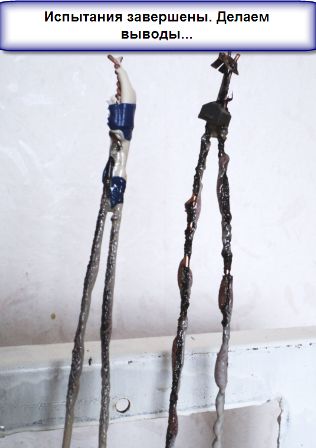
Well, in favor of the VAGOV clamp, I want to say that it can be used in places where the current does not exceed the permissible value, and there is also access for servicing this contact connection.
In the practice of my work was when the switch boxes during the repair were completely closed with plasterboard, it is natural that they should not be serviced at the same time ... just in this case ... In this case I was separated in the boxes with twists and subsequent welding and was 100% sure that nothing would happen with such connections. I do not use any other compounds in such cases.
So the choice is yours, like the speed and convenience - use wago, and if you want a reliable connection - do twist with subsequent welding, so reliable!
This article is written in the continuation of the topic started by Alexander Molokov. In European countries terminal blocks WAGO are the most popular way of connecting wires. We still have a very high suspicion of them, although everyone who is professionally engaged in installing household electrical wiring is known about them. The terminals, connectors, pads "Vaga", "Vagi" already firmly entered the dictionary of the modern electrician.
In this article, let's look at how the WAGO terminal blocks are arranged. We will deal with the example of the most popular and universal series - WAGO 222. These terminals are used for connection and branching of copper single and multi-stranded conductors. The WAGO 222 terminal blocks can be used for connecting lighting equipment, as well as for installation in junction boxes.

The terminals use a special flat-spring clamp CAGE CLAMP.
In the figure: 1 - The CAGE CLAMP clamp from CrNi-spring steel creates a high, programmed clamping force that is automatically adjusted to the conductor section and does not depend on the thoroughness of the maintenance personnel. 2 - CAGE CLAMP presses the conductor surface without damaging it. 3 - Carrier strip made of electrolytic copper with a soft, tin-plated surface, with gas-tight covering of the contact surface of the conductor. 4 - Concentration of the clamping force on the contact surface provides a high contact pressure.
Matrials used to make VAGO terminals
Ease of use.
Reduces the time for wiring (especially this is important for large amounts of work)
Each conductor has a separate terminal location.
The quality of the connection does not depend on the accuracy of the electrician.
When wires are connected with the WAGO terminal blocks, the conductors are not damaged.
Reliable protection against accidental contact with live parts of the connection.
Guaranteed reliability of contacts, eliminating short-circuiting and warming-up at the junction point.
Safety and order in the junction box.
WAGO catalogs were used to prepare the article.
Page 1 of 3
To connect the wires of the internal wiring, professional electricians and home masters increasingly use the spring terminals of WAGO. We will try to find out the secret of the success of these electrical products. We will dwell in detail on the most common series of terminals, we show the correct method of their application for the example of assembly of a typical junction box.
General information about the manufacturer and the design of the terminals.
The beginning of the active development of WAGO (WAGO Kontakttechnik GmbH & Co. KG) is the distant 1951 year. This year, at one of the specialized exhibitions in Germany, WAGO presented its first terminals based on springs. Since then, the company's core business is the technology of spring contact terminals in various electronics fields. In 1973, WAGO produces the first small-size terminals for distribution boxes and receives permits for their wide application. Today WAGO is the world leader in the production of spring terminals and connectors of a wide range of spectrums used in the installation of electrical wiring and microelectronics.
The main advantages of the springs, in comparison with the threaded connection, are, firstly, high vibration resistance of the obtained connection, and secondly, the constant pressure (pressing) at the contact point makes it possible to compensate for the plastic deformation of the metal of the wires.
The terminals allow to carry out a compact, internationally certified wiring, allow multiple reconnections of wires, have technological holes for access to the current-carrying bus with a measuring instrument probe. Almost all series of WAGO terminals for installation do not require the use of a specialized tool.
Contact groups of terminals consist of two parts: a current-carrying bus and a spring. The tire is made of tin-plated copper, thanks to tinning, corrosion protection and an increase in the area of the electrical contact are provided. The flat spring has a complex shape, is made of austenitic steel of chromium-nickel alloying, which allows to achieve the necessary elasticity.
The insulating terminal enclosure is made of modified polyamide of "PA 6.6" and "PA 6.4" or polycarbonate grades. These are flame-retardant, self-extinguishing materials that have a wide range of operating temperatures, resistant to fuels and lubricants and weathering.
Two types of contact groups.
PUSH WIRE®
The flat spring of the contact group of this type performs two functions: it exerts the necessary pressure on the wire, pressing it against the current-carrying bus, and prevents the spontaneous disconnection of the wire due to its special arrangement. The spring is located at a gentle angle to the wire, so that removing the wire from the contact group is much more difficult than inserting. When removing the wire, the spring cuts its edge (end) into the wire. The peculiarity of the contact group type PUSH WIRE is that it does not have to frequent wire withdrawals, as this leads to damage to the wire surface and can sometimes cause deformation of the spring. When the wire is connected, the spring has a weak resistance, but it can be enough to create difficulties for the introduction of a multiwire wire. Wiring a high-class, multi-wire cable without the use of a rigid tip is completely impossible.
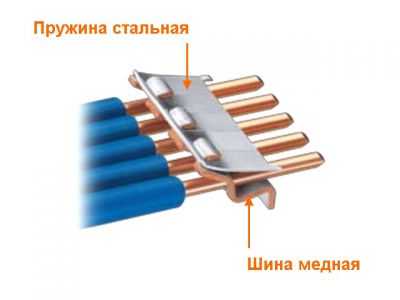

Contact group PUSH WIRE.
CAGE CLAMP®
This design of the contact group was developed taking into account the repeated reconnection of the wire. A flat, curved spring has a rectangular window for inserting a wire from one side and a current carrying bus on the other. By the force of elasticity, it presses the wire and the tire to each other. When pressing on the top of the spring, the window opens slightly, and it becomes possible to insert or remove the wire with zero force. Thanks to this, it is easy to enter wires of any class of flexibility into a contact group such as CAGE CLAMP.


Contact group CAGE CLAMP.
The red arrow shows the point and direction of applying force to compress the spring to open the window before removing or inserting the wire.
Types of wires.
WAGO terminals, depending on the model, serve to connect electrical wires of certain types and range of sections. The figure shows the complete list of wires allowed for connection to the construction and installation terminals of a particular model.
![]()
1. Aluminum single-wire; 2. Copper single-wire;
3. Copper stranded wire; 4. Stranded tinned wire;
5. Stranded wire in the tip-sleeve;
6. Stranded wire with a pin-shaped tip.
WAGO building and wiring terminals for junction boxes.
Series 773-30x.

To this series belong the terminals that appeared on the Russian market among the first and therefore are considered to be evolutionarily outdated today. The terminals were primarily designed to connect aluminum wires, as indicated internally, but allow the use of copper wires. The model range consists of four products in a dark gray body made of polyamide.
Technical specifications of WAGO 773-30x terminals.
| Terminal Model | 773-302 | 773-304 | 773-306 | 773-308 |
|---|---|---|---|---|
| Number of inputs | 2 | 4 | 6 | 8 |
| Appearance and dimensions |
|
|
|
|
| Presence of quartz-zeolin paste | Yes | |||
| Contact group type | PUSH WIRE |
| Types of connected wires |
Single-wire, |
|
24 A at 300 V ( BV) 24 A at 400 V ( ABS, CCA, FIMKO, GL, LR, NEMKO, RMR, SEMKO) |
|
| 85 ° C |



Terminals of the series 773-30x.

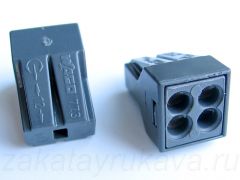
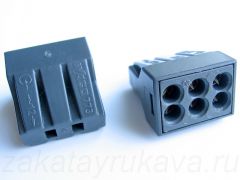

On the terminal housings there are signs reminding of the product model, the length of the wire stripping, the maximum current strength,
maximum operating voltage and others.
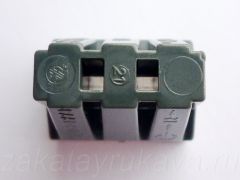
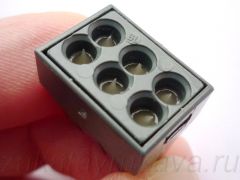
At the rear end of the terminal is one or more holes (depending on the model) for the probe probe (photo left).
Presence of filling of the terminal with quartz-paste paste
easily determined visually (photo on the right).


The length of stripping the wire can be controlled by marking the terminal itself.




Opening the WAGO terminals with a thin flat screwdriver (suitable for many terminal series). In this way, you can remove from inside the piece of wire that was left there after its unsuccessful disconnection.
![]()
WAGO terminals allow you to connect wires from dissimilar metals:
in the contact group type PUSH WIRE terminals WAGO 773-306 are both copper and aluminum wires.
Series 773-32x.

Before us, improved, in relation to the previous series, the terminals. Their main feature is a partially transparent case, which makes it possible to visually assess the depth of the wire. All terminals of this series are supplied without quartz-paste paste. The lineup consists of four products in a body made of polycarbonate with multi-colored inserts. The color of the insert is tied to the terminal model.
Technical specifications of WAGO 773-32x terminals.
| Terminal Model | 773-322 | 773-324 | 773-326 | 773-328 |
|---|---|---|---|---|
| Number of inputs | 2 | 4 | 6 | 8 |
| Appearance and dimensions |
|
|
|
|
| Presence of quartz-zeolin paste | No | |||
| Contact group type | PUSH WIRE |
| Types of connected wires |
Single-wire, multiwire low-class flexibility |
| Admissible sections of single-wire wires | 0.75 - 2.5 mm2 (18 - 12 AWG) |
| Admissible cross-sections of stranded wires | 1.5 - 2.5 mm2 (16 - 12 AWG) |
| The maximum operating current at the specified voltage (according to the test standard) |
20 A at 600 V (UL listed, CSA) 24 A at 300 V ( BV) 24 A at 400 V ( ABS, CCA, GL, KEMA, LR, NEMKO,? VE, RMR, SEMKO) |
| Maximum long-term operating temperature | 85 ° C |


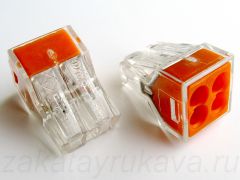
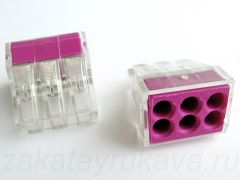

Terminals of the series 773-32x.
The use of special devices called Wago terminal blocks ensures a reliable connection of bundles of cable of different cross sections. Wago clamps are the most popular type of modern mounting hardware in electrical engineering.
The appearance in the market of electrical goods of popular terminals of the company Vago, which produces contact systems, caused the increased interest of companies engaged in electrical installation work. Electricians especially appreciated the reliability of the contacts and the simplicity of the installation operations.
Wago terminals are flat-spring clamps made of austenitic-chromium-nickel steel having spring characteristics that can create a programmable force. The required force of pressure is created automatically depending on the cross-section and the material of the core. The flat-spring clamp evenly presses on the entire contact surface, which ensures that there is no high resistance to resistance. The material of the carrier strip is electrolytic copper with a soft, tin-plated surface.
Requirements for proprietary devices
Producing Wago spring clamps, the company's specialists constantly adhere to the principles of their company.
Requirements to which the Wago terminal blocks:
- security;
- resistance to vibration;
- reliability;
- the compounds obtained do not require further maintenance;
- lack of special skills to perform the installation.
The use of the latest technology in the manufacture of spring clamps contributes to meet these requirements. The actions of the electrician do not violate the forces of the spring clamp, with which the connected wire is pressed. To connect the stripped cable, no additional tools are required. The cores are placed in prepared nests, the body is locked against a latch.
Types of terminal devices
Depending on the Wago connection methods, the terminals are divided into the following categories:
- Wago clamps intended for single use.
- Reusable terminal blocks.
- Wago terminals, which create contact between cables without removing insulating materials.
Clips belonging to the first category are used for single electrical connections, which do not require further disassembly. For connection it is enough to push the stripped ends of the conductors into the connector assembly until it stops, the inner clamp snacks the vein and does not allow to exit. It is not recommended to disassemble the received contacts to avoid damaging the terminals.
To create electrical contacts of wires of different sections, materials, designs, multiple use clamps are used. These terminals are universal, have a clamping mechanism of the original design, allowing you to fix the bundle of veins with a lever. A clamp in the form of a cage can create a force sufficient to hold the cables placed in it. To detach the conductors, open the locking lever or insert a screwdriver to loosen the clamping mechanism.
Wago terminal blocks that work with insulated wires can also be removed and reused afterwards. The body of the device is equipped with a hole for inserting a special test plug of 2 mm to check the current in the resulting electrical circuit and the parameters of the mains without disrupting the integrity of the assembled unit.
It is important that, when installed, the Wago terminal block must be positioned so that it is subsequently freely accessible.
Advantages and disadvantages of Vago's terminal mechanisms
In terminal clamps Vago insulation material is polyamide, which has the ability to neutralize corrosive processes, spontaneously extinguish the flame, withstand temperatures from + 220 ° C to -35 ° C.
The connection obtained with the Wago terminal has a mass of advantages:
- a separate terminal clamp fixing each wire;
- inaccessibility of live parts, accidental touches to them are excluded;
- the quality of the connection of wires does not depend on the force of pressing and qualification of the master;
- clamping force of the terminal corresponds to the section of the cable, which excludes damage and deformation of the conductors;
- reliability of the obtained compound;
- increased resistance to vibration and mechanical damage;
- exclusion of oxidative processes at the junction due to gas tightness;
- small size;
- the resulting connections do not require further maintenance.
In houses where the wiring consists of an aluminum cable, it is often necessary to connect devices with copper current-carrying wires. At ordinary twists in the places of contact of various metals, a characteristic oxide film appears on the aluminum veins. The oxide film helps destroy the aluminum wire and cause a short circuit.
Vago devices are used for mixed assembly, despite the electrochemical incompatibility of aluminum and copper. The use of proprietary terminals guarantees high quality, safety and long life of the combined contact assembly.
The Wago terminal has one drawback - it's a high cost.
Mounting operations when installing branded clips
The most frequent use of Vago terminal blocks was found during the installation of wiring in switch boxes and shields, connections of lighting devices, household equipment. With the help of branded devices, it is possible to create connections from solid and stranded wires.
Emergency situations most often occur at the junction of several wires. This is due to the appearance of a transient resistance in the joints. Of great importance is the selection of suitable connectors for connecting the wires to meet the following requirements:
- absence of screw connections;
- long service life;
- resistance to vibrations, high temperatures;
- increased insulating properties;
- materials of manufacture are steady against fires;
- match the voltage and current in the network.
How to use Wago terminals? Switching of electrical conductors with the help of the Wago terminal is carried out in several operations:
- cleaning of the cable from the insulating material to a distance of 10-15 mm;
- transfer the clamp in the form of a flag to the upper position;
- inserting the strand into the terminal, advancing without zeal until it stops;
- clipping of the clamp when transferring it to the lower position, while the wires are fixed in the terminal.
In the terminals of Vago there is a filling from a special contact paste. Aluminum conductors are automatically deprived of the oxide film and a lubricant is obtained, which protects against oxidation processes. If signs of oxidation in the form of a dark color are observed before installing the aluminum cables to be mounted, a thorough mechanical cleaning should be carried out.
Specific pressure, which is created in the contact point, contributes to a strong fixation of the surfaces of the laid conductors in the layer of soft metals - lead and tin, of which the carrier rail consists. This gives the resulting connected node vibration resistance, reliability and protects the contact place from the damaging effects of corrosion.
If you find a bug, please select the text fragment and click Ctrl + Enter.
There are 4 ways of connecting the conductors, which are provided by the PUE. If you evaluate them in terms of convenience and speed of the operation, reliability of the contact, then the technique using terminals (especially in the home, when working with internal electrical / wiring) - the best option, regardless of the conditions and local specifics.
About the products of the company «WAGO», their main characteristics - our story.
Special feature of the WAGO terminal blocks
Contact clips - spring
What is the advantage of such an engineering solution?
First, a constant "podzim" compensates for the deformation of the conductor metal (for example, temperature). Consequently, during the entire period of operation the reliability of the contact in the terminal block is not impaired.
 Secondly, the springs ensure vibration resistance of the joint.
Secondly, the springs ensure vibration resistance of the joint.
Thirdly, in the process of work, you do not need to use a screwdriver, as it happens when installing "screw" and fixing the tips of the wires in them. Who worked in low light conditions, when installing electrical / wiring in hard-to-reach places, such an advantage of WAGO products will be appreciated.
If you add to this and such a plus (which is inherent in all terminal blocks), like the ease of connecting wires from dissimilar metals (aluminum + copper), then the expediency of using this type of products for electronic / installation work (with spring-loaded contacts) is obvious.
Housing - from modified polymers
The WAGO terminal blocks withstands the influence of aggressive media (for example, fuel), high temperatures (material of production of the category "hardly flammable"), excessive humidity.
Contact groups
For manufacturing current-carrying tires "WAGO" tinned copper (corrosion protection of contact) is used, springs are austenitic steel (chromium-nickel alloying, alloying elasticity).
CAGE CLAMP
This design feature of the terminal blocks allows you to work with conductors of varying degrees of flexibility, and produce multiple switching.

PUSH WIRE
This contact group is specific for use. Firstly, the connection of multiwire conductors, especially with a flexible twisted core, is difficult due to the design of the terminal spring. Secondly, multiple switching is undesirable. The fact is that after putting the plate into place, the veins "cut" into the metal, and partially damage it.
WAGO terminals of this type are mainly used in areas where frequent (operative) wiring reconnection is not provided. They are often called disposable products.

Varieties and characteristics
There are a lot of modifications, so it's hardly necessary to consider the entire assortment. Next - the most used in the home options terminal blocks. More detailed information can be obtained at any point of sale, depending on what types of products are available.
773 Series
The model is -30_. Initially, these products were designed to connect wires from aluminum, for which there is a special paste inside, which increases the quality of the contact. In this group there are 4 types of terminals, which differ in size and number of sockets - from two (model -302) to eight (-308).

Model -32_. More advanced products, featuring a translucent casing with a colored insert. This allows you to visually monitor the process of attaching the conductor and the quality of fixing its tip in the terminal block. The designation is identical - by 2 jacks (-322), by 4 (-324), by 6 (-326), by 8 (-328).

General characteristics
- Cross-sections of conductors (mm2): single-wire - from 0,75; with a twisted core - from 1.5 to 2.5.
- Irab max (A) - 24.
- The temperature range (ºС) is up to +85.
Series 273
The model -503 allows connecting up to 3 conductors in the terminal block with a cross section of 1.5-4 "squares". The presence of the paste makes it possible to work with aluminum wires.

Series 274
The main purpose - circuit switching lights. Models -111 and -122 - with paste, -201 - without it (only for copper wires). The cross section is from 0.5 to 2.5 mm².
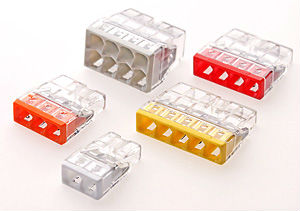
Series 222
Models -402 (2 contacts), 403 (3) and -405 (5). Current up to 32 A, cross section from 0.08 to 4 "squares".
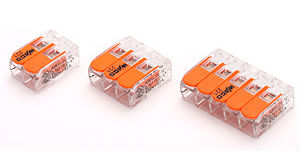
Series 243
The WAGO terminal of this group belongs to the category "micro". Irab up to 6 A, the number of connections from 4 to 8, the cross-section - from 0,6 to 0,8.

862 Series
It is provided for fixing the bodies on any basis, using self-tapping screws. The number of connecting conductors from 2 to 5 at a cross section of 0.5 to 2.5. The maximum current is 25A. These terminals are used only when working with copper wires.

Scope of application
In circuits ~ I with voltage up to 380 V (50 Hz). The WAGO terminals provide a reliable connection of conductors with copper and aluminum conductors. When choosing a product for installation in a specific circuit, you need to focus on its individual characteristics (see above).
Cost of production
It depends on the modification of the "WAGO" terminal block. The prices for products are rather low. For example, products of the series 273 (model 202) - 7 rubles / piece, 222-415 - 32 rubles per unit.



